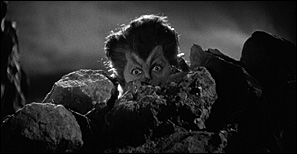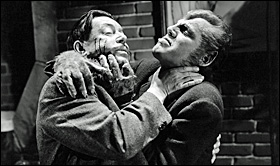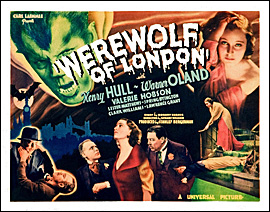Fri 27 Oct 2017
A Movie Review by Jonathan Lewis: WEREWOLF OF LONDON (1935).
Posted by Steve under Horror movies , Reviews[5] Comments

WEREWOLF OF LONDON. Universal Pictures, 1935. Henry Hull, Warner Oland, Valerie Hobson, Lester Matthews, Lawrence Grant, Spring Byington. Director: Stuart Walker.
Warner Oland gives the overall rather dated Werewolf of London a welcome exotic, mystical flair that makes the otherwise somewhat staid film an enjoyable viewing experience. As the first mainstream werewolf movie ever produced by a major American studio, this Universal Pictures release is also notable for its makeup effects by Jack Pierce. A Hollywood legend in his own right, Pierce would go onto do similar work for the much better known (and better movie) The Wolf Man (1941) starring Lon Chaney, Jr.

Henry Hull stars as the titular werewolf, a botanist named Wilfred Glendon. He has recently returned from an expedition in the Himalayas where he had a frightening encounter with a strange beast. That beast, as it turns out, was one Dr. Yogami (Oland), who himself is suffering from lycanthropy.
Yogami arrives in London to tell Glendon that the botanist is about to turn into a werewolf and that a specific plant, one in the latter’s possession, can serve as an antidote. Glendon finds this preposterous, but he has his doubts. These are only strengthened when Glendon notices his hands are getting unusually hairy.

As in The Wolf Man, which was released six years later, Werewolf of London is fundamentally a tragedy. Glendon’s story is a tragic one. His refusal to take seriously his condition, as well as his persistent neglect of his lovely wife Lisa (Valerie Hobson), lead him down a dark and foreboding path that includes murder and ultimately, his own tragic demise at the hands of a Scotland Yard inspector.
But unlike Larry Talbot (Chaney) in The Wolf Man, who appeared as a character in several follow up feature films and became a Universal Monsters icon who is still beloved today, Wilfred Glendon was a character that appeared once and was never heard from again. That is unless there is a remake that could give some fresh life into this somewhat dated feature, something that would give it a little more of a bite for contemporary audiences. Now that’s an idea that would make some fans of classic fans howl at the moon!

October 28th, 2017 at 9:09 am
Hull’s character is too cold & stuffy to garner much audience sympathy, but Stuart Walker’s direction is quite stylish. Based on this and MYSTERY OF EDWIN DROOD I’d like to see more of his work.
October 29th, 2017 at 12:50 pm
And here’s Dan’s full review of this movie, posted on this blog over six years ago:
https://mysteryfile.com/blog/?p=10569
October 29th, 2017 at 10:59 pm
Oland makes for a great antagonist here. Dated or not, it’s full of splendid moments.
April 2nd, 2019 at 2:30 pm
I like it better than The Wolf Man. I like the light makeup–more frightening to me to see the werewolf is still substantially human, but altered. Glendon is cold, but that’s part of the movie’s theme. He’s significantly older than his attractive wife and the werewolf arises as a manifestation of repressed sexuality and his need to dominate the female. He only attacks women, but not any women. He attacks women in promiscuous roles, flirtation society dame, prostitute, vamp.
October 31st, 2020 at 3:47 pm
[…] For my Halloween movie viewing this year, I revisited two films that I had previously watched and reviewed for this blog. United Artists’ White Zombie (1932), reviewed here, and Universal’s Werewolf of London (1935), reviewed here. […]